Pablo Beach, Florida (now Jacksonville Beach) was a small village with wood frame buildings, streets of sand, outhouses, no sewage system, no street lights, and high sand dunes on the ocean front in 1910. Only 249 people lived there. There was a train that stopped several times a day on its way to the docks in Mayport on the southern bank of the St. Johns River to the north. Passengers came from Jacksonville to Pablo Beach to enjoy the ocean and the local amusements or to stay for the summer. For most of the year, there were few passengers but come the "season" (mid-April until mid-September), the little village came alive. Overnight accommodations, saloons, restaurants, and amusement venues flourished. Most adult permanent residents worked for one of these establishments. The railroad, the lifeline, supported a few. The village officially became a Town in 1907 but it was stagnant. Even counting the 81 residents of the hinterland, there were only 330 people in the area. For all of Precinct 11, that is, the easternmost part of Duval County excluding Mayport, there were 326 people in 1900. Why would anyone want to live there? As I have researched and written about the beaches of Jacksonville,1 the question of why people lived in Pablo Beach, a somewhat primitive place in 1910, instead of modern Jacksonville with its skyscrapers and modern amenities has puzzled me. So I have tried to figure it out by using various censuses, particularly the US Census of 1910 for the Town of Pablo Beach and Pablo Precinct. By searching for and examining other sources, we can go beyond census data. Ordinary people rarely leave many writings about their lives or get mention in newspapers and books unlike public officials and prominent businessmen.
A quick sketch of Pablo Beach is necessary. The Jacksonville & Atlantic company created it in 1884, selling lots for summer cottages and permanent homes, encouraging hotels and other tourist facilities, and operating train service to and from Jacksonville on a regular basis. Seaside summer cottages for the wealthy and well-to-do required permanent residents as did the limited tourist trade. Had Henry M. Flagler not bought the railroad in 1899, keeping the only viable line of communication with Jacksonville open, Pablo Beach might have disappeared. Flagler needed coal for his Florida East Coast Railway so he bought the existing railroad, switched to standard gauge, and extended the line north from Pablo Beach to Mayport to his coal docks. Pablo Beach was saved, but the luxury Continental Hotel he built in an area he called Atlantic Beach made it the place for people with money.2 Pablo Beach lost the founders' hope that it would become the destination of the moneyed class.
Visualizing this tiny community as it existed over a century ago is very difficult. One thinks of Jacksonville Beach, which it became in 1925, and not the few short blocks it was in 1907-1910. Little remains. In Pablo Beach, almost all of the road names were different, the exceptions being 1st, 2nd, and 3rd Street North and South, Pablo Avenue, and Shetter Avenues. Other streets were platted but not used. As only one public-use building remains, the mission chapel of St. Paul's-By-The-Sea Episcopal Church, now refurbished and sitting on the grounds of the Beaches Museum and History Park.3 The train tracks, that vital link to Jacksonville, were removed in the early 1930s after the bankruptcy of the Florida East Coast Railway in 1931. To help the reader, I first provide maps and images of the Town of Pablo Beach. Later, the essay includes images of some of the important people of the Town. Showing who the Town leaders were is another way to provide insight into the community.
The Town of Pablo Beach was incorporated on May 22, 1907 by the state legislature.
1907. CHAPTER 5830--(No. 235).
Be it Enacted by the Legislature of the State of Florida:
Section 1. A municipality to be called the Town of Pablo Beach is hereby established in Duval County, the territorial boundaries of which shall be as follows: Beginning at a point where the projection of Wakulla Avenue 15th Ave N would intersect the Atlantic Ocean, thence southerly along said ocean to a point where the projection of the center of Hillsboro Avenue 15th Ave S would intersect the Atlantic Ocean, thence westerly along said projection and the center of Hillsboro Avenue to a point of intersection with Tenth Street, thence northerly along the center of Tenth Street to its intersection with the center of Wakulla Avenue, thence along the center of Wakulla Avenue and the projection thereof to the point of beginning.4
After the legislature authorized the town, Governor Napoleon Bonaparte Broward appointed the government of Pablo Beach. They held their first meeting on June 15, 1907. Henry M. Shockley became Mayor with J. Denham Bird as treasurer and G. W. Wilkerson as clerk. Charles H. Mann was the President of the town council which consisted of him and James E. Dickerson, Edwin E. Willard, William Wilkerson, Edwin E. Suskind, Alexander Stevens, William H. Shetter, Charles M. Greiner, and T. H. Griffith5 They passed public safety and sanitation ordinances and created a license fee system to create an income stream for the town and regulate private business. By July 12th, the town had $131.50 in its treasury. They had trouble keeping a town marshal; the first resigned after a week. As Caren Burmeister wrote in her "When hogs had to be banned from town" in the May 26, 2007 edition of Shorelines, Florida Times-Union:
The marshal was required to be on duty from 9 a.m. to 11 p.m., with an hour break for lunch and dinner, and could be called out day and night. In addition to protecting people against crime, he was expected to meet each train as it arrived at Pablo Beach, oversee the town's stock and other property, take a census twice a year and ensure compliance with sanitation ordinances, including removing excrement. He was paid $60 a month.
This was not as onerous as it sounds to the modern ear. Henry Ford created a fierce uproar from other capitalists when he instituted the eight hour day in his factory and doubled pay to $5 a day in 1914. He understood that they had to have money if they were going to buy his cars and he would, thus, increase his own profit. The US government established eight hour day for railroad workers in 1916 and for most workers in 1937 under the New Deal. In 1907, people worked long hours for six days a week and $720 a year was much better than the average workman's wage of $500-$600 a year.
The pool of 70 white males 21 and over made recruitment difficult. No African Americans would have been hired. Of course, major problems were only likely to arise during the short tourist season.
By August, 1907, the council had streets laid out and marked and, of course, renamed after themselves, their friends, famous people and places in Florida.
These 1909 Sanborn Fire Insurance Company maps show the settled areas.6 The center of business activity or "downtown" was Pablo Avenue which stretched from the ocean front westward to the train station near current 3rd street. One street north, Dickerson Avenue (1st Avenue North), was considered North Pablo Beach in the early 1920s. The railroad tracks swerved to just west of 2nd Street North and proceeded to Atlantic Beach, East Mayport, and Mayport. The noise and dirt of the train discouraged settlement to the north. Most settlement was south of Duval Avenue (today's Beach Boulevard) but not many short blocks south.
Pablo Avenue (originally Putnam Avenue) housed the Ocean View Hotel on the ocean front, an establishment that contained amusements, a bath house, restaurant, and an electric power station. One would walk west to other amusement venues or go to the dance pavilion on the south side of the street, bars, a general store, and restaurants until one reached the Florida East Coast Railway railroad station. Some African Americans lived southwest of the train station on Shetter and neighboring streets or on Railroad Avenue. Most people lived south of Railroad/Duval Avenue (Beach Boulevard) where and built their churches and public school. In addition to the Hotel Pablo on 2nd Street South and Orange Avenue (2nd Avenue South), St. Paul's-by-the-Sea occupied the northeast corner of 2nd Street South and Orange Avenue (2nd Avenue South). The public school was on the northwest corner. On 1st Street South between Suskind Avenue (4th Avenue South) and Mann Avenue (5th Avenue South) stood St. Paul's Catholic mission. Neither church held services every week. Neither enjoyed enough congregants to support priests. The Episcopal mission was active during the season; the Catholic mission waited until the diocese sent someone.
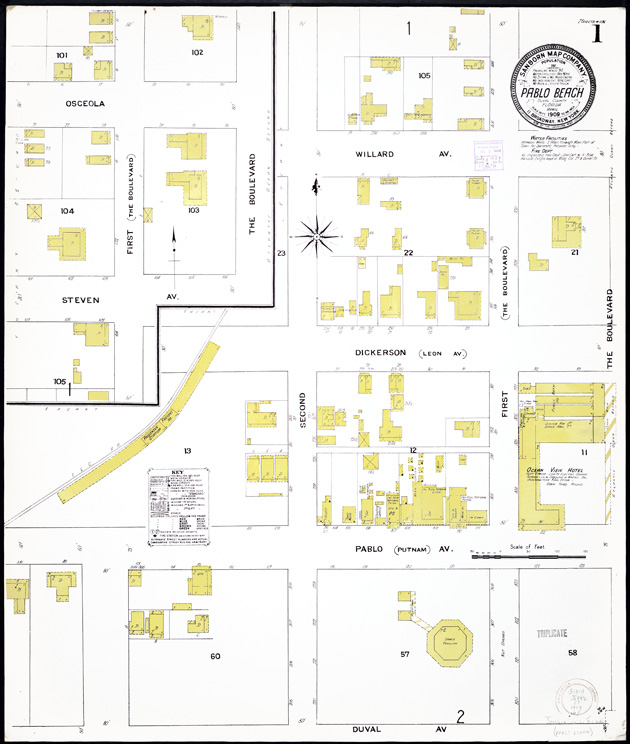
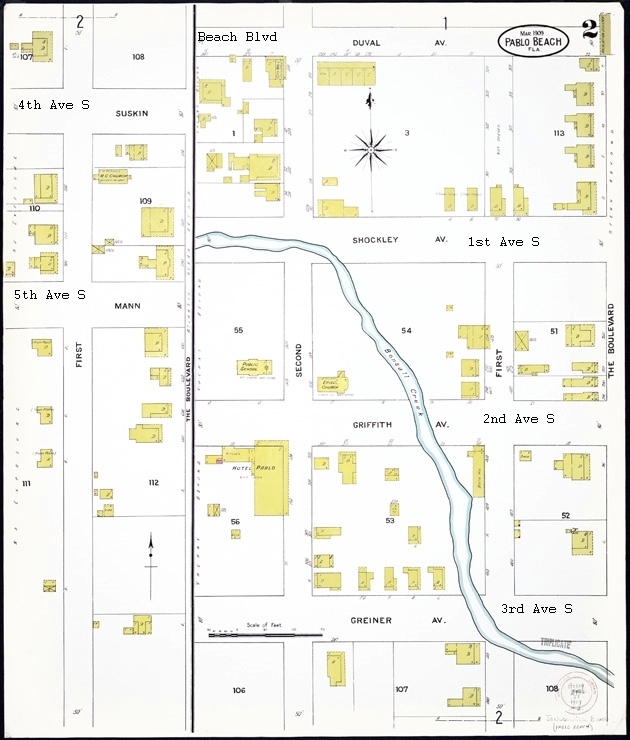
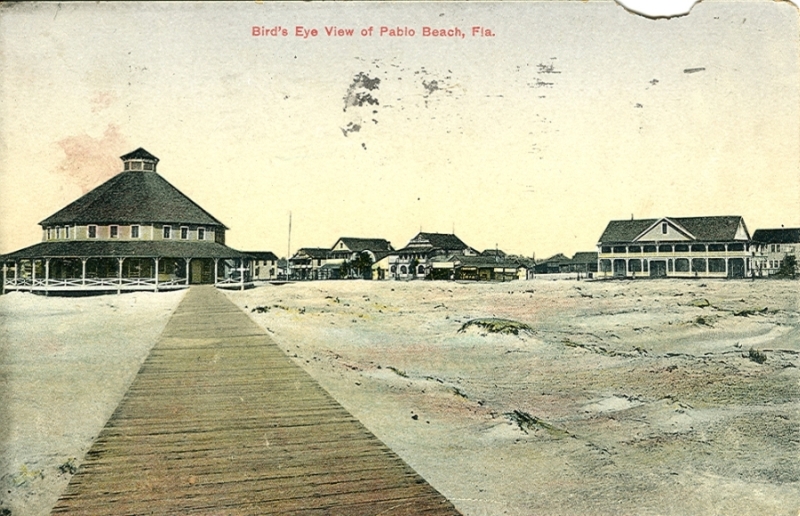
Two hotels served the town. The biggest was the Ocean View at the foot of Pablo Avenue, the largest building in town; the other the Hotel Pablo on the southeast corner of 2nd Street South and Griffith Avenue 2nd Avenue South. The Hotel Pablo was a substantial two story building but not as grand as the Ocean View Hotel which spread across the ocean front between Pablo Avenue and Dickerson Avenue 1st Avenue North. W. H. Adams, Sr. and his wife Juliette ran a fine hotel which was the center piece of the tiny village. Almost anything a guest could want--rooms, food, amusements, bath houses, water, and electricity--were provided. In fact, its artesian well and electric power plant supplied neighbors. The Hotel Pablo was substantial but not as grand as the Ocean View. It was but commodious and convenient to the beach.
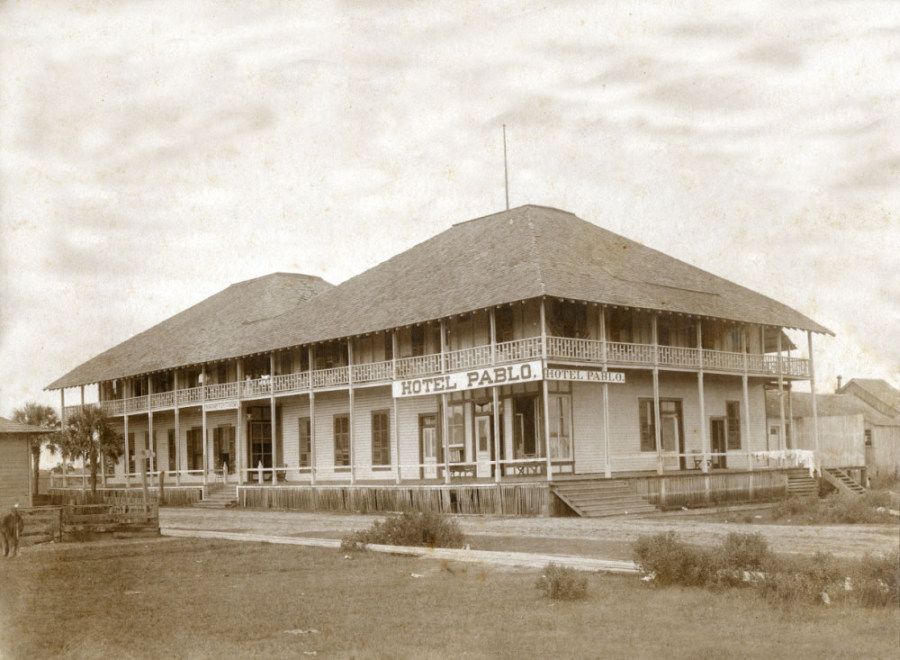

North Pablo Beach was Dickerson Avenue (1st Avenue North and Willard Avenue (2nd Avenue North) and then largely unsettled streets north. Dickerson Avenue had many fine homes as the post card below illustrates.
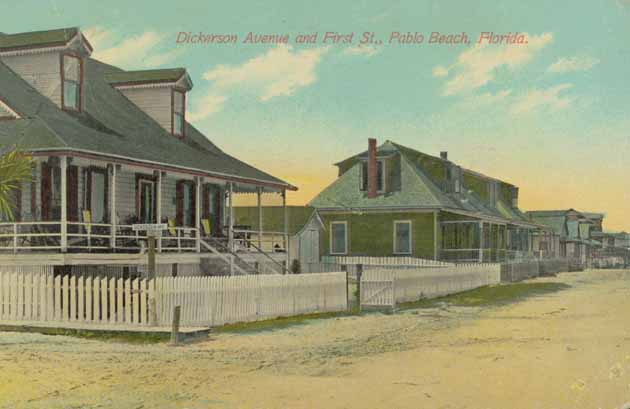
Mayor Shockley lived a few short blocks south of the hotel on Shockley Avenue (1st Avenue South and 2nd Street South). One block further south was Griffith Avenue (2nd Avenue South) which was Palmetto Avenue with the public school and homes. Hotel Pablo was on 2nd Street South. Bonsal Creek crossed 2nd Street South on its way to the ocean.
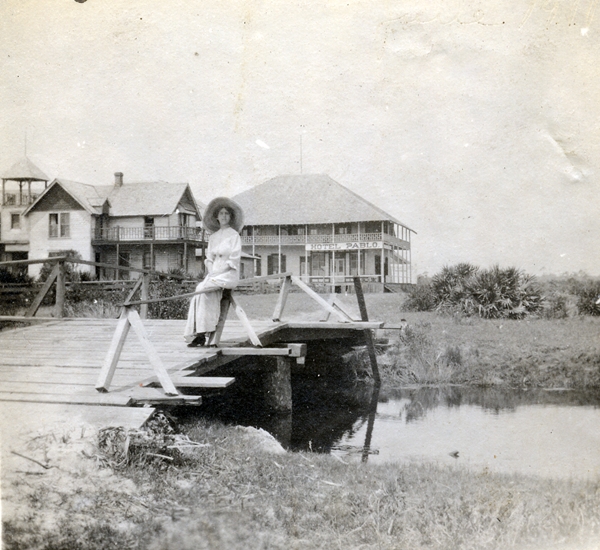


Most residents did not live in homes as nice as those of prominent families. The dwellings afforded by the elite were more substantial and comfortable than those of the average person. In fact, many families took in boarders or roomers to make ends meet; the 24 boarders constituted 9.6% of the total population of Pablo Beach and 12.7% of people 18 and over. Of the 81 people who lived out of town, 14 (17.2%) were boarders. If photographs of average family homes in this period were taken. they have not surfaced.

Because the town had no widespread electrical system, most residents relied upon lanterns in their abodes to keep the darkness away. The April-September tourist season made it a little brighter, of course, as the bars, the amusements, the dance pavilion, and hotels catered to their desires. Electricity was available near the Ocean View. The reliance upon lamp lighting and fireplace made fire a constant threat. Fire destroyed the Hotel Pablo and neighboring houses in 1910 and the Ocean View Hotel and much of the Jacksonville Beach business district on July 29, 1926. It was not at all like Jacksonville. Compare Pablo Avenue with this photo of downtown Jacksonville.
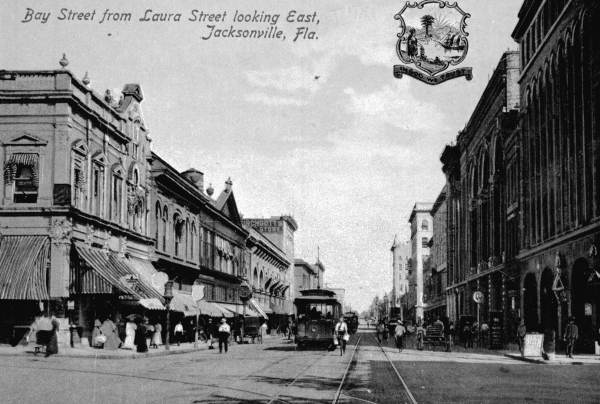
People went to the beach burg to enjoy the hard packed sand beach, the ocean, breezes, escape from ordinary life, and to seek amusement. Humans like large expanses of water and the ocean is certainly that but it is also dynamic, sometimes turbulent, sometimes calm. Beaches gained popularity when they became stark contrasts to urban, industrial places. A stroll along the strand relaxed mind and body even while wearing the fashions of the day. Some changed into bathing gear to enjoy the surf.
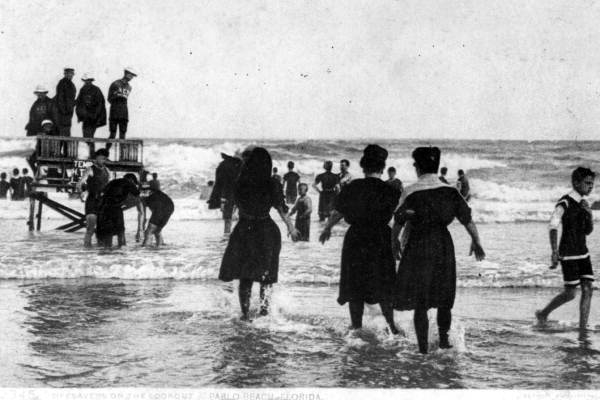
Visitors also delved into other pleasures. The modest public pavilion sat directly directly on the ocean front.

A much larger private one sat in a Pablo Avenue lot of its own across from and south of the Ocean View Hotel.
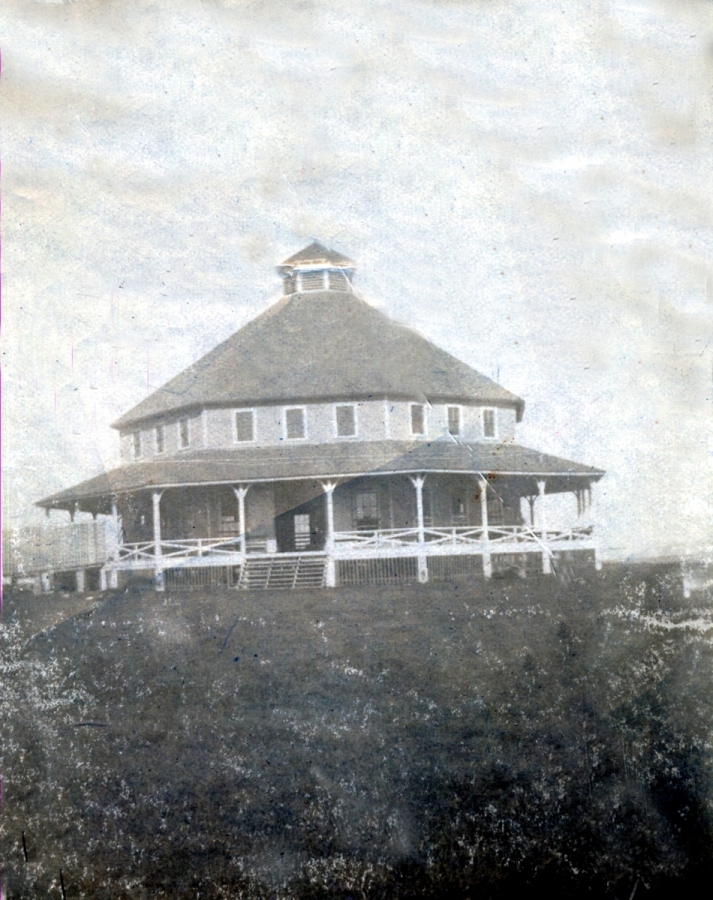
Dancing and roller skating were the order of the day; seven years later it would be the core of a much larger entertainment venue called Little Coney Island (see the diagram at the end of this essay). Most of the action took place on Pablo Avenue with its saloons, restaurants, shooting gallery, soda fountain, and beer garden. One could also buy groceries and other supplies. For men so inclined, the Palmetto Lodge was discreetly a few blocks north of town.
Through these rare 1910 photographs,we glimpse two beach scenes of 1910. Although sun damaged, they reveal that people walked on the strand dressed the same as if they were walking down a big city thoroughfare. Mark Phillip Simmons, who kindly gave me access to these images, also provided close up greyscale images in order to focus on details.
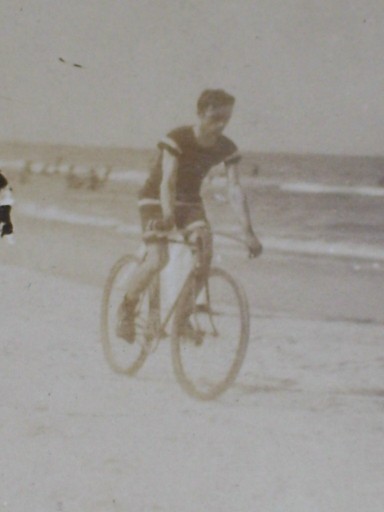
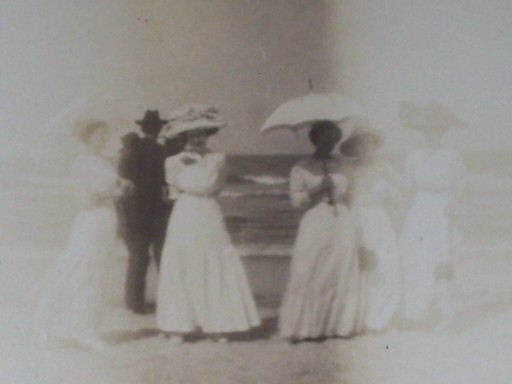

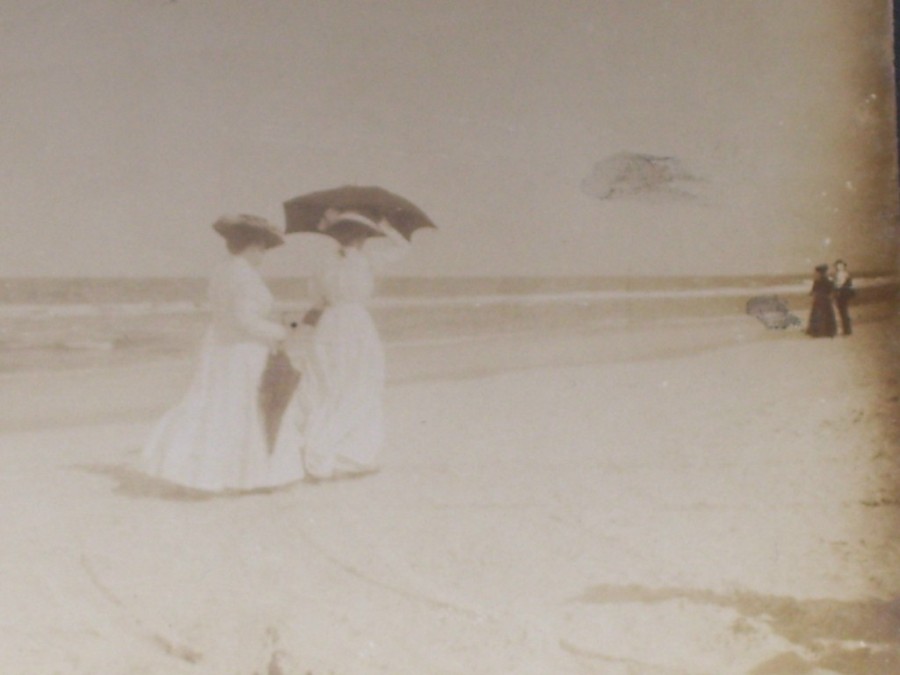
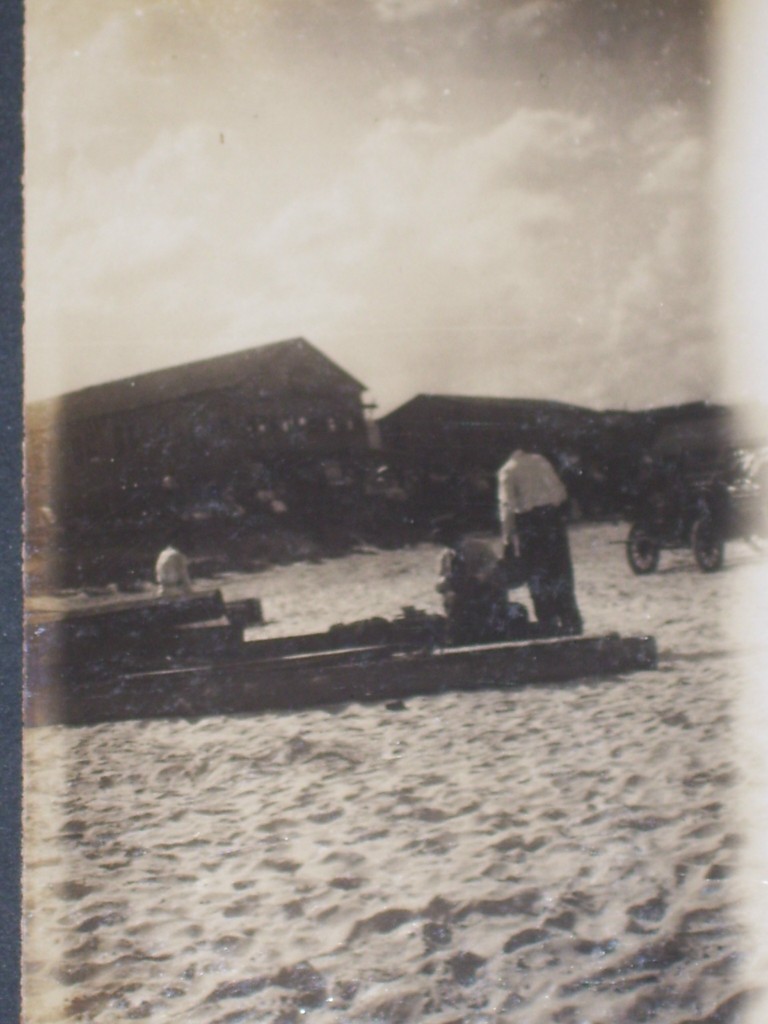
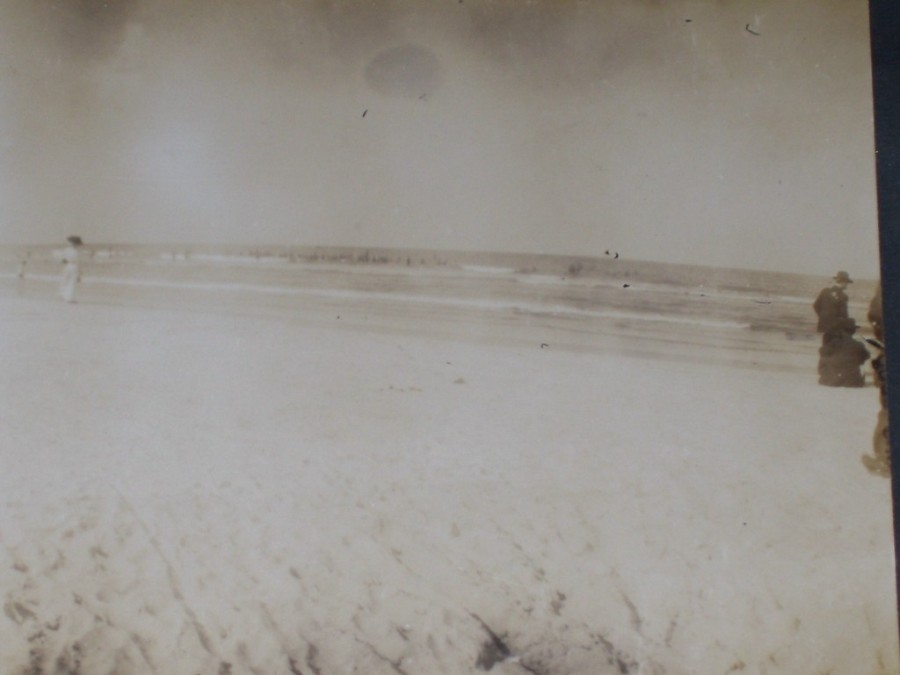
Governing this little resort burg even when its population ballooned during the "season" was scarcely an onerous task in 1907 when it officially became a Town; those who did were a varied lot. Few were natives and not all lived in Pablo Beach. Although interesting people, they were not famous and information hides in bits and pieces in all kinds of documents or disappeared.7
A fair amount is known about Mayor Henry M. Shockley. He was a newcomer to Florida and the beach, having been born in Kent County, Delaware on August 30, 1856. His parents, John B. Shockley and Mary Mcilvahe, were also born in Delaware. John was involved in the tourist business two years after Henry was born for he signed a publicity blurb for the resort Kitts Hummock as it is known today.
Kitts Hammock, near Dover, Delaware, the Hotel at this favorite resort during the summer months, is now open for the reception of boarders and visitors from all parts of the United States. The subscriber has thoroughly renovated and otherwise fitted up his premises with all the comforts and conveniences usually found at the most famous watering places. New Bath Houses have been erected for the increased accommodation of guest who desire to indulge in the delightful and healthful recreation of Salt Water Bathing.The larder of the Hotel is under charge of the best and most scientific cooks in the State. The Bar is kept constantly supplied with the choicest Wine and Liquors. Extensive Stables are on the premises and guest with horses can rely on the best attendance by experienced hostlers.
Fishing and Sailing parties provided for as a fine fast Sailing Sloop will serve the guest during the season. Board can be had per day, week or month. Charges are moderate. Guest from abroad can come by Railroad to Dover, where Hacks and Private Carriages can carry them to the Beach in one hour.
--John B. Shockley8
The first hotel on the coastal area near Dover had only been built in 1846 and cottages came thereafter as people with money built them to enjoy ocean breezes in the summer. So the Shockley family was familiar with the development of a beach community.
By the time the future mayor was fourteen 1870, his parents' household also included his 39 year old father, his 89 year old grandmother Elisabeth Shockley, his 11 year old sister Poleine, his 6 year old brother William, and three females and two males who may have been family but were most likely boarders or roomers--Anna A. Cooper, 11, Sophia Tamlinson, 29, Jean Danaho, 2, Joseph Smith, 25, and Charles Harris, 16. His mother Mary is not present. Presumably she had died. Henry was living in a multi-family situation, however. Perhaps his father ran a boarding house.
Ten years later (1880) at age 25, Henry had moved to East Jacksonville, Florida, a suburb of Jacksonville, and headed a household comprised of himself and Ada M. Morrill, a 22-year old woman born in New Hampshire, and Frank Ivory, a 14 year old servant born in Florida.
He was still single in 1885 according to the Florida census of that year; he was a merchant and lived in the Mungin household, an African American family. "Skip Mungin", age 35, was the head of the household; his wife Eda was 40; and their daughter , "E", was 12. Living with the Mungins and Shockley was Mary Schoffield, 38, a white woman who was listed as a Wife, of whom we don't know. It was an unusual living situation for a "white" man living in the South in 1885. In 1887, he was living in a house on Shell Road in Fairfield, also a suburb of Jacksonville.
He married a German woman, Ottilie Knauer, on April 20, 1892, when he was 35 years old. She was the daughter of August Knauer who owned A. Knauer Materialwaarenhandlung and was born in Gotha, Thuringia, Germany in 1865. August sent his children to the United States to live. Ottilie's brother William Christian Knauer, born February 1867 in Gotha, migrated to Jacksonville where he became a grocer, real estate agent, and banker until his death on August 14, 1931. Shockley cast his lot with the Knauer family.9
We know a bit more about him. He was postmaster of the town and paid $257.75 in 1891.10 In 1894, he sent a white substance specimen to the Smithsonian National Museum for identification.11 He acted the agent of a Jacksonville man, C. Hopkins, who rented out a furnished cottage to a Lt. Tillibury of the 7th Army Corps in 1898; there was damage to the house and Hopkins was trying to get compensation.12 In the federal census of 1900, he was a listed as a grocer and Ottilie as a saleswoman. His father, a 69 year old minister, lived with them. Also in the house were two servants, a 15-year-old German girl named M. Rosenbaum and Lilena Simmons, a 58 year old cook. They owned Shockley's Lunch Pavilion on Pablo Avenue. From the surviving photographs, it appears very modest but had some pretty accoutrements.

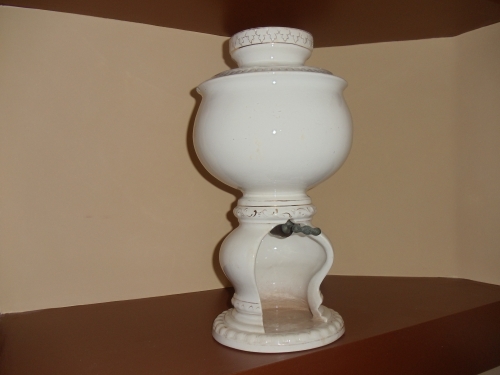
The Shockleys had other ways of earning money. He served a four-year term as notary public from November 11, 1908.They let rooms in their home at the corner of Second Street South and Shockley Avenue (1st Avenue South). They never had children but members of the Knauer family often lived in their house. When Henry died in 1914, Ottilie continued to rent rooms and eventually an adjoining building.13
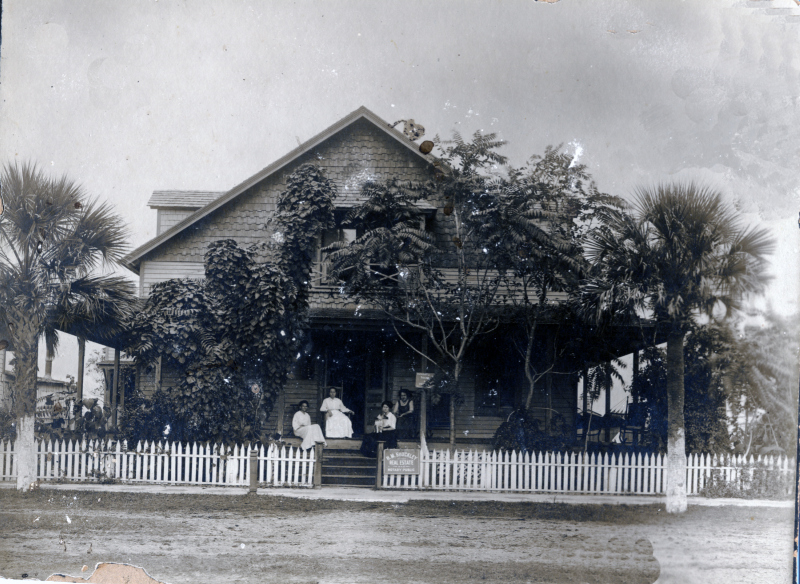
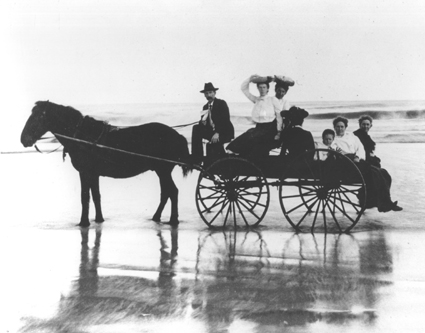
The 65-year-old Town Councilman James E. Dickerson had lived in Pablo Beach at least since 1887 when he was listed as owning a grocery and general store. According to Eleanor Scull, who, with her husband, was one of the first two people to live at Pablo Beach, "The second house at the beach was built by Mr. and Mrs. Dickerson. They had a store and she was afterwards postmistress." He was born in Maryland whereas his wife Celaia (63), was an Illinois native. Their store was on Dickerson Avenue which was once Leon Avenue and would become 1st Avenue North. In 1920, it would still be considered "North Pablo Beach!"14 They lived on South 2nd Street. His longevity and prominence guaranteed him a place on the town council but leadership went to Charles Henry Mann whose interests drew him into the Jacksonville orbit. Dickerson was a Notary Public from March 1906 to March, 1910 and became Mayor in 1910.
The President of the Town Council, Charles Mann, lived most of the year in Jacksonville but was allowed to vote and hold an important office in the new town.15 He was president of the Pablo Development and Power Company. He was an Englishman from Kent, born December 26, 1876, who arrived in Jacksonville in 1883 after spending two years in Detroit. At age 16 in 1892 with some business courses tucked under his belt from night school, the young man entered the hide and skin trade. First he owned the Southern Hide and Skin Company at St. Johns Avenue and King Street and, eventually, the American Oak and Leather Tanning Company. Adept at turning a profit, he invested in real estate in rapidly growing Jacksonville. By 1909, he was vice-president of Citizens Bank and vice-president of Welaka Mineral Water Company which was incorporated on November 15, 1907. A Pablo Beach street was named for him. Although he stayed involved in Pablo Beach development, he lived in by the time of the 1910 federal census.

Councilman Edward E. Willard was a 59-year-old Floridian but whose mother, Anne Hartridge, like Mann, was born in England. His father, Nathan P. Willard, was born in Massachusetts. His wife and four children-- Mary M. (58); Jane L. (25); Helen E. (23); Ann H. (21); and Thomas E. (19)--were born in Florida. Willard Avenue (considered "North Pablo Beach") became 2nd Avenue North. The family had moved from Pablo Beach by 1910; by 1920, Mary had died and he, Jane, Helen, and Thomas were sharing a household in Jacksonville with his daughter Ann and her husband John S. Telfair and their two children. He died in June, 1921.
Councilman William W. Wilkerson was an 49-year-old Englishman with a 45 year-old English wife who had migrated with him to New Jersey by 1886 and then to Florida. He owned a livery stable which she managed. In 1910, the family lived on Pablo Avenue as did their 23 year old married son William J., born in New Jersey, and daughter-in-law, Ruth, 24, born in Florida. William J. was a driver for an express company, that is, a delivery service. The father's household in 1910 included his wife Esther (age 48), two daughters, Elizabeth (20) and Amelia (15), two sons, Henry (18) and Christopher (10), and A. J. Tucker, a 24 year-old boarder who was a telegraph operator.
Councilman Edward E. Suskind was a German, born June 1840, who was married to Frida Euting Suskind , born in Stuttgart, Germany in March 1842. In 1900, they had two daughters Frida and Lilly, born 1881 and 1885 in Florida respectively. The 1910 US Census listed only the 68 year old Edward, the 65 year-old Frida, and the 25 year-old single daughter Frida living at 412 South 1st Street. Suskind managed a saw mill. He was a very successful businessman as the above photos show. Suskind Avenue became 4th Avenue South.
Councilman Alexander Stevens was born in 1870 in Florida. He was a fisherman in 1900 living outside the town limits with his sixty-one year-old widowed mother, Charlene Jamison, but presumably lived in town in 1907 when he was appointed to the Town Council and gave his name to Stevens Avenue (today's 3rd Avenue North). By 1935, he lived at 412 Pablo Avenue, was widowed, and was a carpenter.
The Tennessean William H. Shetter, born 1850, and his wife Mary, born 1854, owned the Buen Retiro saloon and lived on South 2nd Street. Shetter Avenue was a westward extension of Duval Avenue which was named Railroad Avenue in 1917 but became Mundy Drive and Beach Boulevard. His business was good enough that he could equip his restaurant with a 2-ton refrigeration plant made by Boland Machinery Company of Chicago.
Dr. Charles M. Greiner, born into a prominent family in Mount Clemens, Michigan on November 14, 1865, studied in his home state, Canada, and Wisconsin before studying medicine under a local physician and then at the Detroit College of Medicine and Surgery, graduating in 1897. He practiced in his home town and in Williamston, Michigan where he married Alice Grover. They moved to Jacksonville in 1900 where he practiced medicine. The 1910 census does not show him as a beach resident; he must have had a second home in Pablo Beach when he was appointed a councilman in 1907. Greiner Avenue is now 3rd Street South. Bonsal Creek flowed across it to reach the ocean.
Still another 1907 Town Councilman lived in Jacksonville. In 1899, The Rev. Thomas H. Griffith, a 53 year-old Canadian, lived on 36 West Adams Street in Jacksonville in his Richelieu Hotel with his wife Eliza, his brother-in-law Eldridge Hobson, a nephew George Kirk and his wife, his niece Ester, and numerous boarders. He was a minister by profession. He had immigrated to the United States in 1863. He owned the Riverside Hotel on Riverside Avenue. Although he was named to the town council in 1907 and had an avenue named after him (2nd Avenue South), the 1910 census still has him in Jacksonville running the hotel. Perhaps he did a short stint in the lodging business in Pablo Beach.
Of the nine members of the 1907 Town Council, five were born outside the United States. Of the four American born, two were born in Florida. Three of the nine were Jacksonville residents who owned summer cottages at the beach. The foreign-born and the non-Florida born men simply represented the attractiveness of the Jacksonville area to immigrants. There were not many white males over 21 years of age so Governor Broward chose some prominent Jacksonville men who owned summer cottages.
The town bureaucracy was small, of course. The town treasurer was J. Denham Bird, an Atlantic National Bank teller in 1905 who, with his wife Isabella lived at 105 East Monroe Street in Jacksonville. In Pablo Beach, Bird Avenue was today's 6th Avenue South. The tax assessor, John M. Mier, was 42 years old when appointed. In 1910, he was a 45 year old housing contractor in his second marriage to Evelina (52) who was also in her second marriage. She had been first married to a Gonzales by whom she had a 13 year old daughter, Anna Gonzales, born in Florida but whose father was Spanish. John and his parents were born in Florida as had been Evelina (her parents were Georgians). They lived on 2nd Street South.
The city clerk in 1907 was G. W. Wilkerson, a name which does not appear on the 1900 and 1910 federal censuses for Pablo Beach. There is a George W. Wilkinson in Jacksonville in the 1930 U.S. census who would have been 39 in 1910. His father was born in Georgia; his mother in Northern Ireland; but he and his wife Mary were born in Florida. This man may not have been the city clerk in 1907 but there is no one else by that name in the census or Jacksonville city directories. The town marshal in 1907 was a William Jones, presumably the man who quit very quickly after being hired. He does not appear in the 1910 Pablo Beach census.
There was some new blood among the 1910 town officials but also 1907 Town official. James Dickerson became Mayor without opposition. There were thirteen candidates for the Town Council; the nine elected were:
Ewing, Fox, Gonzalez, Rannie, and Shockley were new compared to the 1907 Council but Shockley, of course, had been mayor.
Robert N. Ewing, a housing contractor, was elected to the Town Council in July, 1910 while living on Dickerson Avenue (1st Street North). The 60 year old man, like so many others was a Yankee, born in Ohio. His father was born in Ireland, his mother in Vermont, and his wife of 32 years, in Pennsylvania. Their daughter, Lillie, a Floridian, was 25 in 1910 (born in 1885) and did not live with them.
Samuel W. Fox first saw Florida in February, 1864 as a United States soldier in a unit from his father's home state, Company H, 17th Regiment, Connecticut Infantry when it was ordered to Jacksonville. The Company went to St. Augustine, Welaka, Picolta, and neighboring places and then back to Jacksonville where it was mustered out on July 19, 1865. He settled down there, marrying Joanah F. Hart on December 5th of that year. Either she died or they divorced because the thirty-two year old Fox married the 23 year old Ida B. Howe on September 27, 1874. She was a Floridian, he a New Yorker like his mother. He made his career in Jacksonville. In 1891, he is listed in the Jacksonville city directory as a lawyer, notary public, and a broker of loans and conveyances with an office at 8½ West and a home at 128 W. Ashley, In 1905, he had moved his office to 106 Main Street and his home to 1958 Oak Street in the Riverside neighborhood.
By 1910, when the 69 year old Fox had married a third time and acquired 19 year old twin stepdaughter daughters, Beulah and Bertha, and the children he had sired with Florence: a 7 year old daughter name Emma, a 5 year old son named Charles, and a 3 year old daughter named Thelma. Florence was a 41 year old Kentuckian. Also living in the household were Florence's mother, Anetta C. Wendt, a 66 year old Pennsylvania and her 73 year old father Marcus who was born in New Jersey. Fox died on May 3, 1912. His widow collected an army pension for which he had filed August 18, 1904 because he was a disabled Civil War veteran.
William Ross Rannie, born August 24, 1867 in Nashville, Tennessee of Scottish parents, went to Jacksonville in 1902, the year after the great fire. By 1905, he and his wife Lillie lived at 419 East Forsyth Street in 1905. He was Secretary and Treasurer of the West-Raley-Rannie Company which specialized in real estate, lumber, and grazing lands. He also was interested in the beach area, joining in the promotion of a paved highway from South Jacksonville to the beach. Such a road would open the beach to further real estate development. In 1906, he was the 2nd Vice president of the Jacksonville Automobile and Motor Boat Association which organized an automobile race from Burnside Beach to 12 miles south on April 9, 10, 11, and 12 over a 30 mile course. The April 9th was devoted to bicycle racing. Automobile owners, especially those who owned race cars, have money and influence and this racing marathon was another effort to promote a motorway from Jacksonville to the beach. By 1908, work was started; in summer, 1910, Atlantic Boulevard opened as the first paved highway in Florida.
As his interest in Pablo Beach grew, he moved there and involved himself deeply in its affairs while continuing his business ties to Jacksonville. He became president of the A. J. Cesery Company, a very large construction company, president of the Florida Land Investment Company, and vice president of the South Jacksonville Ferry Company which was important for getting to the beach from Jacksonville. In 1913, he would become President of the Pablo Beach Improvement Company, Inc., a real estate company whose principals included A. J. Cesery on the Board of Directors, Vice President Thomas Clarke, a druggist and vice president of the Atlantic Seashore Company who had a Pablo Beach summer residence, Treasurer George H. Mason who owned the Everett and Mason Hotels and a summer home at the beach, and Secretary Malcolm McClellan who was Mayor of Pablo Beach in 1913 and President, Pablo Beach Board of Trade. He lived at Pablo Beach. The Company published a large, illustrated brochure to entice people to buy beach property to build houses and stores.17
When the 45 year old Rannie was elected to the Town Council, his was one of ten households on 1st Avenue North. He and Lettie (38), his wife of 19 years had their daughter, Frances Peyton (2), his wife's mother, Frances Goodloe (69), and a cook, Laura Thomas (30) who was a married woman and mother of six, living with them. He was a widower by 1930; census data from that year shows the following in his household: Frances Peyton, Frances P. Goodloe, and Carrie B. Rounds (50), born in Delaware. Rounds was listed as a roomer but could have been a servant. Rannie died on June 30, 1932; he was almost 65.
Rannie Avenue in Jacksonville Beach is the one-block street east of 1st Street North between 10th Avenue North and 11th Avenue North, not much to remember this important developer and politician.

James G. and Emma Gonzales18 lived on 2nd Street South when he was elected to the town council; he was thirty-two. His father Manuel was a Spaniard, not unusual in a region where many people of Spanish, usually Minorcan, ancestry lived. James' mother, Evelina, was a Floridian as was his brother Anthony, a plumber, who lived next to him. James was an "engineer" in a lumber yard which meant he was a mechanic. He would later become city electrician. He worked for the City of Jacksonville Beach for a long time (1914 through 1945), and also gave the city the land for Gonzales Park. Their daughter Marie was three in 1910. The family had grown by 1920. He was 42, Emma was 37, Marie was 13, Anna was 5, and Richard was a year and a half.
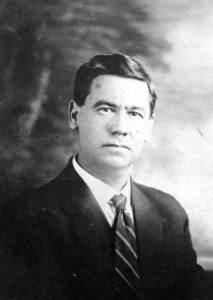
Frank O. Miller, 38, ran unopposed for Town Treasurer. He was a Pennsylvanian by birth with parents born in Germany. At the beach, he owned a music store. His wife Elizabeth Cline Miller (41) was also born in Pennsylvania but with Pennsylvania parents. She and Frank had been married 13 years and had a 4 year old son, Frank, Junior, who was born in Florida in 1905. Like Gonzales they lived on 2nd Street South.
John Morgan Mier (45), who was tax assessor in 1907, beat Ed Gerkin19 for the job of Town Clerk in 1910. Some of his background is mentioned above. His parents were Anita Basilica Andreu and Venancio José Mier. He grew up in St. Augustine with six brothers and sisters. Married and divorced by 1900, he had moved to New Smyrna, the place where the first Minorcans arrived in Florida. He moved back north to Pablo Beach, having married again to an older woman, Evelina (52). By 1920, he was Justice of the Peace in Beach.
The 1910 Town government was decidedly non-Southern. Of the Town Council, six (two-thirds) were born within the United States but only two were born in Confederate states--Rannie and Gonzales, who was the only Floridian. The three foreign-born members--Griffith, Mann, and Wilkinson--served in 1907. Miller, the Treasurer, was a Pennsylvanian. Mier, Town Clerk, was a Floridian.
So much for officialdom; who lived in Pablo Beach and its environs in 1910? How many households were there and who lived in them? Were they white or black, employed or unemployed, native born, or immigrants from other states or other countries? Among the adults, how common was marriage? How did they earn their keep? I used the official censuses for the Town of Pablo Beach and Precinct 11 Pablo to answer these and other questions.20
The original census sheets can be found here. Some parts of them are difficult to read. I reduced most of the information to this spreadsheet. One name, James C. G. Drewry, is written above the name column but in a different handwriting. There is no other information provided. Searches did not show him as living in Pablo Beach so I have excluded him.21
Those who want to see my spreadsheet for the Town of Pablo Beach can click here.
In this narrative, I tried to bring some "life" to the names on the census pages as well as trying to analyze the data. At times, I was able to identify an individual through one or more other sources. For stylistic reasons, the age of the person is placed in parentheses after the name. The basic census unit was the household which we usually think of as a family unit. Although usually the case, the term also meant solitary individuals, those living alone.
|
Category |
Number |
% of Town |
|
Male |
128 |
51.4% |
|
Female |
121 |
48.6% |
|
White |
189 |
75.9% |
|
African American |
60 |
24.1% |
|
Over 18 |
188 |
75.5% |
|
Over 21 |
176 |
70.7% |
|
65 and older |
16 |
6.4% |
|
Under 18 |
61 |
24.5% |
|
Married |
113 |
45.4% |
|
Divorced |
9 |
3.6% |
|
Single |
102 |
41.0% |
|
Single under 18 |
58 |
23.3% |
There were 128 males (51.4%) and 121 females (48.6%) living in this town of 249 persons. Of the total population, 189 (75.9%) were whites. The census taker considered 50 persons (20%) to be black, and 10 persons (4.1%) to be mulatto. Today we classify these 60 persons (24.1%) as African American. The adult population was 188 persons (75.5%) using 18 and over as the definition of adult but was 176 (70.7%) if 21 and older was adult. Children numbered only 61 (24.5%). On the other hand, there were only 16 persons (6.4%) who were 65 or older. Three were in their seventies; the oldest, Henry Allen, a mulatto who owned his own home on Railroad Avenue, was 78. He and his wife Nancy (62) of forty-eight years had a daughter-in-law, two grandsons, and a married couple boarding with them. Of the 113 married people, three were 17 year old women. Nine of the 113 were in second marriages. Only nine of the adults had been divorced, five of them were white. There were 102 single people but 58 were under 18.
Most Pablo Beach people were immigrants to Florida. Only 95 (38.2%) were born there and, of those, only 25 had both parents born there. Of the Floridians, 16 had one or more parents born outside the United States, most commonly in Germany. Most of the 153 immigrants (61.4% of the total population) were born in other states but 31(12.5% of the town) were born abroad as shown in the table below. Not included in the table is J.B. Leins whose birthplace was not on the 1910 census. His parents were both born in German making it likely that is was as well.
|
COUNTRY |
NUMBER |
|
Australia |
1 |
|
Canada |
2 |
|
England |
6 |
|
Finland |
1 |
|
Germany |
11 |
|
Greece |
4 |
|
Ireland |
3 |
|
Russia |
1 |
|
Spain |
1 |
|
Sweden |
1 |
|
TOTAL |
31 |
Immigrants from other states are shown in the following table. Not surprisingly, neighboring Georgia supplied the most. South Carolina, a close by state, and New York, a distant state, each had 17 immigrants. Pablo Beach was full of 50) carpetbaggers (20% of the total population), if one used the term of thirty years before.
|
STATE |
NUMBER |
|
|
Alabama |
3 |
|
|
Arkansas |
1 |
|
|
Connecticut |
1 |
|
|
Delaware |
1 |
|
|
Georgia |
30 |
|
|
Iowa |
1 |
|
|
Illinois |
5 |
|
|
Indiana |
1 |
|
|
Kentucky |
2 |
|
|
Massachusetts |
4 |
|
|
Maine |
1 |
|
|
Maryland |
1 |
|
|
Michigan |
2 |
|
|
Mississippi |
3 |
|
|
New Jersey |
1 |
|
|
New York |
17 |
|
|
Nevada |
1 |
|
|
North Carolina |
8 |
|
|
Ohio |
4 |
|
|
Oregon |
1 |
|
|
Pennsylvania |
8 |
|
|
South Carolina |
17 |
|
|
Tennessee |
3 |
|
|
Virginia |
4 |
|
|
Wisconsin |
1 |
|
|
TOTAL |
121 |
Another way to understand Pablo Beach in 1910 is by looking at the occupations and the number of people in them. The following table provides a count but it is not as clear as one would want. What is a "keeper," an owner of a business or just employed as a manager. There eight people listed as keepers, six as managers, and one as owner but we know that some keepers were also owners. Suffice to say that fifteen people commanded businesses. Many of these occupations could have been classed as servants and skilled workmen. The term "engineer" meant a mechanic, someone who kept machines in operating condition. Hotels and the railroad were major employers. The newsboys were young boy who probably worked part-time.
|
OCCUPATION |
NUMBER |
PERCENT |
OCCUPATION |
NUMBER |
PERCENT | |
|
Actor |
1 |
0.8% |
Manager |
6 |
4.7% | |
|
Agent |
6 |
4.7% |
Marshall |
1 |
0.8% | |
|
Baker |
1 |
0.8% |
Merchant |
8 |
6.2% | |
|
Book finisher |
1 |
0.8% |
Newsboy |
3 |
2.3% | |
|
bookkeeper |
1 |
0.8% |
Nurse |
1 |
0.8% | |
|
Broker |
1 |
0.8% |
Odd jobs |
1 |
0.8% | |
|
Carpenter |
15 |
11.6% |
Operator |
1 |
0.8% | |
|
Chambermaid |
1 |
0.8% |
Owner |
1 |
0.8% | |
|
Contractor |
2 |
1.6% |
Painter |
3 |
2.3% | |
|
Cook |
15 |
11.6% |
Piano tuner |
1 |
0.8% | |
|
Dressmaker |
1 |
0.8% |
Plasterer |
1 |
0.8% | |
|
Driver |
6 |
4.7% |
Plumber |
1 |
0.8% | |
|
Engineer |
2 |
1.6% |
Porter |
2 |
1.6% | |
|
Enumerator |
1 |
0.8% |
Sales lady |
2 |
1.6% | |
|
Fisherman |
4 |
3.1% |
Salesman |
3 |
2.3% | |
|
Foreman |
1 |
0.8% |
Servant |
2 |
1.6% | |
|
Harness maker |
1 |
0.8% |
Stenographer |
1 |
0.8% | |
|
Inspector |
1 |
0.8% |
Switchman |
1 |
0.8% | |
|
Keeper |
8 |
6.2% |
Teacher |
2 |
1.6% | |
|
Laborer |
8 |
6.2% |
Waiter |
2 |
1.6% | |
|
Laundress |
7 |
5.4% |
Waitress |
1 |
0.8% | |
|
Lawyer |
1 |
0.8% |
TOTAL |
129 |
100.0% |
Besides the fifteen people listed as having their own income, there were 104 people without a job but 51 were under the age of 18, 7 were 65 or over. Of the 46 remaining, 43 were women of whom, 38 were married. Seven of the unemployed adults were white single females; two were African American married females.
There were 85 households in Pablo Beach, Florida on April 15, 1910. Thirty-three (38.9%) were owned by the head of household. Of the total households, 21 (24.7%) were occupied by one person. Twenty households were headed by women (about 23.5%). Fourteen heads (4.8%) were African America whereas African Americans made up 18% of the total population.
The occupations of the heads ranged from actor to piano tuner. Seven were agents, usually real estate agents. The widow Minnie Dickerson (40) was a baker. There was a book finisher and a produce broker. Eleven were carpenters. Ewing and Mier were building contractors. Two African American women were cooks in private homes whereas a third cooked in a hotel. Two men, one white, one black, were delivery men, that is, express drivers. Two were listed as mechanics: Charles B. Jones worked on a gas engine, James G. Gonzales as an mechanic in a lumber yard. George G. Jones listed himself as a census enumerator; one wonders what he did with the rest of his time. Frank Allen was a fisherman The Irishman J. W. Murphy had a good job as a foreman for the FEC Railway; there were four railroad laborers, two white and two black, to supervise. Max Wagner was a housing inspector but we do not know for whom.
Cora Taylor, aka Cora Crane, had been intimately involved with the famous novelist Stephen Crane until his death in 1900; she owned and ran The Palmetto Lodge located at Monroe Avenue (8th Avenue North). She had established this brothel at the beach in 1907, having been successful with one in Jacksonville. She was Boston-born of the wealthy Howorth family and spent her life living as she pleased, including multiple marriages and being a war correspondent in Greece and Turkey. Her marriage to Crane was of the common law variety. Her end came on Sunday, September 4, 1910. Cora, who had suffered a slight stroke earlier in the year, had noticed a car that was stuck in the soft beach sand in front of the Palmetto Lodge and went out to offer assistance. But, after she and others had pushed the vehicle clear of the sand, she went back indoors to lie down and never regained consciousness.22
R. J. Raley and Celia Hawthorne kept boarding houses. William H. Adams, Sr. , about whom I have written, owned the Ocean View Hotel but his wife Juliette managed it because he had a thriving wholesale fish and fishing supplies business in Jacksonville. Max Pollick and Louis Strauss operated restaurants. William Shetter and George Zapf kept saloons. George's son Gene, a World War I veteran, would own the Bamboo Bar in Jacksonville Beach in later years. Five women heads were laundresses. Joshua Smith was a lawyer. Alexander Bigelow managed a phosphate company while Suskind managed a saw mill. A German, W. John Oehler, managed a bakery. Seven men were merchants. J. H. Jones had a general store. E. H. Donner, C. O'Donald from Ireland, and Andrew Cordas from Greece had grocery stores. Donner eventually became an important real estate entrepreneur; he was important enough in 1901 to have Donner Avenue (5th Avenue North) named after him. James B. Jones and A. Bergman from Russia sold refreshments. The Town Marshall was J. D. Smith. One man was listed as doing odd jobs. Twelve people had "own income" listed as occupation but they could not all have been retired since only half were 60 or older. William W. Wilkerson owned the livery stables, one of the most important businesses when horse transportation was essential. There were two house painters, one of whom also did signs, a plumber, and a plaster. Loban Guthrie the piano tuner; how many pianos could there have been.
In some households, the head was not the sole breadwinner. James Cohen (40) was a black carriage driver in the household of Taylor-Crane. Dorothy Biscoe (25), a teacher "at home" (a tutor?) was the single 25 year old daughter of Sarah Elizabeth Biscoe (66), a retired Australian widow who had immigrated in 1877. Estella Lee (25) was a black woman who cooked for the Joshua Smith household of five. Laura Thomas (30) was a white cook for the Rannie family. Hobson Turner (10) was a black newsboy helping his mother Henrietta (43) a laundress. S. Gordon (43) a white dressmaker boarded with the widow Dickerson. Clyde Smith (16), the son of the Town Marshall, drove an express wagon. Charles Smith (28), a carpenter, boarded with R. J. Raley. The Englishwoman, Esther Wilkerson (48), managed her husband's livery stable and their son, Henry (18), was a express driver. Marcus Sallas (22), a railroad switchman, lived with his parents, John R. and Ella Sallas. They had lived in Mayport ten years before. Jackson Foster (40) made harnesses while boarding with the Samuel W. Eline family.
The African American Henry Allen family on Railroad Avenue had a daughter-in-law, Mamie (28), working as a cook in a private home while her twin 12 year old boys, Alonso and Vanado, worked as newsboys. Two boarders, F. S. Jinkins (Jenkins) and his wife Marie, both 27, worked as a hotel cook and as a boarding house chambermaid, respectively.
Blanche Pollick (26), wife of Max, was a waitress in his restaurant. George Roegler (22) who had immigrated from Germany in 1910, cooked in a restaurant, and boarded with his fellow German Louis Strauss (45). Fannie Jones (25) the single daughter of J. H. Jones , was a "sales lady" in her father's general store. In the same household, Henry Moss (22) was a laborer and widower Sam M. Wilkerson (59) was a carpenter. Catherine Donner (31) was a "sales lady" in her husband's general store on Pablo Avenue. George Gordas (35), who came with the family from Greece in 1909, worked in the family grocery business. They had a Greek boarder, Charles Vetis (31), and Charles Fulton (19), a Floridian, who were salesmen for the business.
Adams, Sr. (45), the Ocean View Hotel proprietor, employed many people who worked in his home, the hotel. His wife Juliette (35) managed the hotel and her brother, Lemuel Platt (33) was the bookkeeper for the wholesale fish company in Jacksonville and probably the hotel. Adams employed seven African Americans in his household: Mary Love (30), William Riles (26), and James Thomas (27) as cooks, Thomas Grant (21) as a porter, James H. Stiles (25) and Burt Russell (27) as waiters, and H. J. Whitfield (41) as a carpenter.
Still more households enjoyed two wage earners. Judia Attison, a 52 year old widowed African American cook, lived with and cooked for Francis C. Fanss (45) a Pennsylvania woman. Two of John Oehler's boys, Charles (21) and Willie (17) were fishermen instead of working in the family bakery. So did Hugh Seward (43) a boarder. Evelyn Wagner (25) the divorced daughter of Max Wagner, the house inspector who arrived in the United States from Germany in 1870, was a stenographer for a wholesale iron company. Alfred W. Webber (49) who arrived from England five years before and Jack Edwards (27) who arrived from Ireland in 1894, both did odd jobs while boarding with the widow Celia Hawthorne (33), also English. The Zapfs, originally from Germany, employed Essie Drayton (22), a black Floridian, to cook for a household that numbered six persons including boarders A. M Gallett (55), a carpenter and Walter L. Anderson (22) a house painter from Illinois. Alexander Bigelow's sister-in-law, Annie H. Porter (64), a schoolteacher, was part of the family whereas Mary Ellen Mansfield (49) was a private nurse and Merle Bowlin (24), a nephew living with his wife, managed a gas works. Maggie Maxwell (24) the house cook had her seven year old daughter, Verdia, living with her. Arthur Thomas (20) was a hotel porter where his mother, Vallie (42), was a cook. In the African American William Terrell (40) family, husband, wife (30), and sons Richard (17) and James worked as laundress, day laborer, and driver, respectively. There were three other daughters and two sons ranging from 13 to 2 in the house.
Households were more than nuclear families or a single person; instead, they might be any number of people living there. The kinds of relationships to the head varied. There were 45 wives but no husbands, 23 daughters, 1 adopted daughter, 3 stepdaughters, 30 sons, 1 stepson, 1 daughter-in-law, 2 granddaughters, and 5 grandsons. Then there were the other relatives living there: 1 fathers, 3 mothers, 1 mother-in-law, 3 husband's sister, I wife's brother, I brother, and 2 nieces. There were 24 boarders, an arrangement which provided income for the head and cheaper accommodations for the boarder. It was common for the arrangement to be room and board. There were 16 servants of whom 7 worked in a hotel. Heads of single person households totaled 21 as we have seen.
Eleven households were on 1st Street North, four on the 2nd Street North Alley, eight on Railroad Avenue, four on Willard Avenue, twelve on Pablo Avenue, and thirty-seven on 2nd Street South. The last two pages have no street names on them so it is not clear where these households were.
|
STREET |
HOUSEHOLDS |
|
1st Street North |
11 |
|
Willard Avenue |
4 |
|
2nd Street North Alley |
4 |
|
Railroad Avenue |
8 |
|
Pablo Avenue |
12 |
|
2nd Street S |
37 |
|
Unknown |
8 |
|
TOTAL |
84 |
The eighteen white children (6-14 years old) were educated at public expense; the six African American children (6-14 years old) were taught in a private home. Such was racial segregation. The Pablo town census identifies two teachers: Annie H. Porter (64), a single, white, Florida native and sister of Mary P. Bigelow, who taught in a school and Dorothy Biscoe (25), the single daughter of Sarah Elizabeth Biscoe who taught at home, presumably as a tutor. The public school was grades one through eight. In South Pablo Edith J. Burnett (29), the single, white daughter of Theodore Burnett, is listed as a public school teacher; she had to have taught in the Pablo School. The African American children were taught by a dedicated grandmother, Rhoda L. Martin (64), a laundress. She may have taught older children as well. The school no doubt served children who lived outside of town. In South Pablo, there were seven white children (4 from the Brown family) and six African American children for a total of 37 children. Because a child was school age, he or she may not have attended school, especially the older ones. They may have needed to work.

SOUTH PABLO AND CANAL CAMPS
The two original census sheets for Precinct 11 Pablo can be accessed by clicking here and here.
Pablo South and the Canal camps housed 81 people who lived in the unincorporated area south and south west of the Town, now north of Butler Boulevard and west of Third Street South. By the standards of the day and the lack of good roads, the two miles to Pablo Avenue could be quite a journey. So people living in these two areas "went to town" when necessary. In Pablo South they farmed, fished, cut trees, made turpentine, and sold the products of their labor. The Canal Camps, near South Pablo, were temporary, in existence from 1908 until 1912 while the Florida Coast Line Canal & Transportation Company (FCLC&TC) dug a canal trough the Diego Plains (Palm Valley) to connect Pablo Creek/San Pablo River to the Tolomato River north of St. Augustine. The unrealized hope of the state government was that the canal would be a commercial shipping lane. Even after the United States government took over the project, widening and deepening the canal, it never became a commercial thoroughfare. It did create a barrier island from a peninsular.
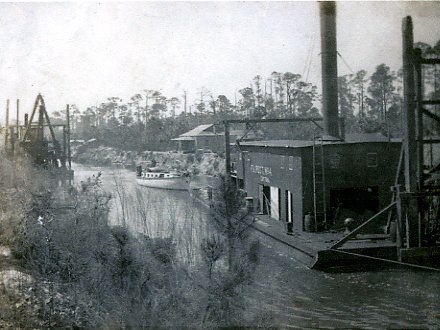
BRIEF CHART OF CANAL CAMPS
|
SURNAME |
FIRST |
STATUS |
SEX |
RACE |
AGE |
MARITAL |
BIRTHPLACE |
OCCUPATION |
WORKPLACE |
|
Saunders |
William H. |
Head |
M |
W |
41 |
M |
KS |
Foreman |
Dredge |
|
Saunders |
Hattie L. |
Wife |
F |
W |
40 |
M |
KS |
None |
None |
|
Saunders |
Elbridge |
Son |
M |
W |
18 |
S |
FL |
None |
None |
|
Saunders |
Anna E. |
Daughter |
F |
W |
16 |
S |
FL |
None |
None |
|
Saunders |
George H. |
Son |
M |
W |
14 |
S |
FL |
None |
None |
|
Saunders |
Dorothy |
Daughter |
F |
W |
6 |
S |
FL |
None |
None |
|
Hasselden |
Henry |
Boarder |
M |
W |
24 |
S |
SC |
Engineer |
Gas engine |
|
Hickman |
John H. |
Boarder |
M |
W |
22 |
S |
NC |
Runner |
Dredge |
|
Stephens |
Elias |
Boarder |
M |
W |
36 |
S |
FL |
Carpenter |
Ship |
|
Hasselden |
James B. |
Boarder |
M |
W |
18 |
S |
SC |
Launchman |
Canal |
|
Sanderson |
Adrian |
Boarder |
M |
W |
28 |
S |
MI |
Gun Launchman |
Canal |
|
Brazeale |
Maquess |
Boarder |
M |
W |
25 |
S |
FL |
Runner |
Dredge |
|
Douglas |
Rufus |
Boarder |
M |
W |
29 |
S |
GA |
Gun laborer |
Dredge |
|
Knight |
Joseph L. |
Head |
M |
W |
35 |
S |
NC |
Operator |
Turpentine |
|
Smith |
William H. |
Head |
M |
W |
27 |
S |
England |
Engineer |
Gas engine |
|
Kenler |
Arthur |
Head |
M |
W |
46 |
S |
MD |
Watchman |
Dredge |
The Canal Camps contained only seventeen people, all white, with four heads of household. Three of these heads were single men. William H. Smith (27) was an English mechanic in charge of a gas engine. Joseph L. Knight (35) was a North Carolinian who was an operator in turpentine production. Arthur Kenler (46) from Maryland was a watchman on the dredge. William H. Saunders (41), the dredge foeman, headed a large household consisting of his family and boarders. He and his wife Hattie (40) were Kansans but had lived in Florida since 1892. They had two sons, Elbridge (18) and George (14), two daughters, Anna (16) and Dorothy (6). Living with or adjacent (the layout of the household is not clear) were seven boarders. The Hasselden brothers from South Carolina, Henry (24) and James B. (18, were an mechanic for the gas engine and a dredge launchman, respectively. Twenty-two year old John H. Hickman, originally from North Carolina, was a runner as was Marquess (Marquess?) Brazeale (25), a Floridian. Adrian Sanderson (28) was a gun launchman from Michigan whereas Rufus Douglas (29) from Georgia was a gun laborer on the dredge. All but Knight were directly involved in canal building. He stayed in Florida, marrying Clara Clark, twenty-two years his junior.
SOUTH PABLO
Click here for a brief chart of South Pablo.
South Pablo was about two miles south of Pablo Avenue down to the St. Johns County line and stretching east from the Atlantic Ocean and west to the Canal (the Intracoastal Waterway). Sand dunes, trees, scrub country, small lakes, and a few farms characterized this little region. The Browns worked a 160-acre farm on land that is now the Rip Tide and Sanctuary housing subdivisions, west of South Beach Parkway and north of Butler Boulevard. In 1910, going to town was an undertaking. Children did go to school and supplies were purchased but these folks were hard working country people.
|
SURNAME |
FIRST |
STATUS |
SEX |
RACE |
AGE |
STATUS |
BIRTHPLACE |
OCCUPATION |
WORKPLACE |
|
Williams |
Blumhart |
Head |
M |
W |
42 |
S |
Germany |
Fisherman |
|
|
Smith |
Putnam S |
Head |
M |
W |
53 |
S |
OH |
Fisherman |
|
|
Salanes |
Charles |
Boarder |
M |
W |
23 |
S |
Sweden |
Fisherman |
|
|
Cowan |
William R |
Head |
M |
W |
37 |
M |
NC |
Carpenter |
House |
|
Cowan |
LouEllen |
Wife |
F |
W |
27 |
M |
FL |
None |
|
|
Cowan |
Leila |
Daughter |
F |
W |
1 day |
S |
FL |
None |
|
|
Cowan |
Clarence |
Son |
M |
W |
7 |
S |
FL |
None |
|
|
Cowan |
Luthia |
Son |
M |
W |
4 |
S |
FL |
None |
|
|
Cowan |
Wilson |
Son |
M |
W |
16 mos |
S |
FL |
None |
|
|
Classen |
George A. |
Head |
M |
W |
44 |
M |
SC |
Wholesale grocer |
Grocery |
|
Classen |
Lula |
Wife |
F |
W |
39 |
M |
Canada |
None |
|
|
Williams |
Charles B |
Head |
M |
W |
35 |
S |
MA |
Machinist |
Ship building |
|
Blankenship |
H. |
Head |
M |
W |
33 |
M |
GA |
Employee |
|
|
Blankenship |
Milagros |
Wife |
F |
W |
33 |
M |
Cuba |
None |
|
|
Erickson |
Andrew L |
Head |
M |
W |
40 |
M |
PA |
Merchant |
Poultry |
|
Erickson |
Edith |
Wife |
F |
W |
34 |
M |
PA |
None |
|
|
Tosh |
Tom |
Boarder |
M |
W |
28 |
S |
VA |
Salesman |
Poultry |
|
Sullivan |
Ernest |
Head |
M |
W |
29 |
M |
FL |
Fisherman |
|
|
Sullivan |
Laura |
Wife |
F |
W |
27 |
M |
GA |
None |
|
|
Deloach |
Frank |
Boarder |
M |
W |
18 |
S |
FL |
Fisherman |
|
|
Parker |
Frank |
Head |
M |
B |
61 |
Wd |
GA |
None |
|
|
Parker |
Major |
Son |
M |
B |
12 |
S |
FL |
None |
|
|
Brown |
Thomas D |
Head |
M |
W |
56 |
M |
GA |
Dairyman |
|
|
Brown |
Annie Sadler |
Wife |
F |
W |
38 |
M |
FL |
None |
|
|
Brown |
May |
Daughter |
F |
W |
16 |
S |
FL |
None |
|
|
Brown |
Asbury |
Son |
M |
W |
14 |
S |
FL |
None |
|
|
Brown |
Lagenia |
Daughter |
F |
W |
12 |
S |
FL |
None |
|
|
Brown |
Ida |
Daughter |
F |
W |
10 |
S |
FL |
None |
|
|
Brown |
Ada |
Daughter |
F |
W |
8 |
S |
FL |
None |
|
|
Brown |
Thomasene Oleta |
Daughter |
F |
W |
2 |
S |
FL |
None |
|
|
Myzelle |
Napolian B |
Head |
M |
W |
52 |
M2 |
FL |
Carpenter |
|
|
Myzelle |
Addie |
Wife |
F |
W |
35 |
M |
FL |
None |
|
|
Myzelle |
Eugene |
Son |
M |
W |
3 |
S |
FL |
None |
|
|
Myzelle |
John A |
Son |
M |
W |
7 mos |
S |
FL |
None |
|
|
Hill |
George |
Head |
M |
B |
45 |
M2 |
SC |
Farmer |
|
|
Hill |
Mitter |
Wife |
F |
B |
33 |
M |
SC |
None |
|
|
Hill |
Frank |
Son |
M |
B |
14 |
S |
SC |
None |
|
|
Hill |
Landie |
Son |
M |
B |
11 |
S |
SC |
None |
|
|
Hill |
Mary Bell |
Daughter |
F |
B |
7 |
S |
FL |
None |
|
|
Hill |
Willie |
Son |
M |
B |
5 |
S |
FL |
None |
|
|
Middleton |
Primaus |
Boarder |
M |
B |
22 |
S |
SC |
Laborer |
Odd jobs |
|
Brown |
James |
Boarder |
M |
B |
34 |
Wd |
SC |
Laborer |
Odd jobs |
|
Young |
Freddie |
Boarder |
M |
B |
9 |
S |
GA |
None |
|
|
Longstaff |
Henry S |
Head |
M |
W |
62 |
Wd |
England |
Farmer |
|
|
Pitt |
John H |
Head |
M |
W |
53 |
M |
NC |
Turpentine |
|
|
Pitt |
Wilhemina |
Wife |
F |
W |
46 |
M |
GA |
None |
|
|
Sugg |
Willie E |
Boarder |
M |
W |
21 |
S |
NC |
None |
|
|
Reece |
Mack |
Head |
M |
B |
35 |
M |
GA |
Chipper |
Turpentine |
|
Reece |
Callie |
Wife |
F |
B |
32 |
M2 |
NC |
None |
|
|
Reece |
James |
Son |
M |
B |
6 |
S |
FL |
None |
|
|
Reece |
Masie |
Daughter |
F |
B |
3 |
S |
FL |
None |
|
|
Reece |
Varrie |
Daughter |
F |
B |
newborn |
S |
FL |
None |
|
|
McFaden |
Ben |
Head |
M |
B |
52 |
Wd |
SC |
Dipper |
Turpentine |
|
Burnett |
Theodore W |
Head |
M |
W |
52 |
M |
IL |
Own income |
|
|
Burnett |
Carrie E |
Wife |
F |
W |
51 |
M |
IL |
None |
|
|
Burnett |
Edith J |
Daughter |
F |
W |
29 |
S |
SC |
Teacher |
Public school |
|
Burnett |
Ezra R |
Son |
M |
W |
27 |
S |
SC |
Manager |
Saw mill |
|
Burnett |
Henry E |
Son |
M |
W |
25 |
S |
SC |
Salesman |
Retail lumber |
|
Burnett |
Walter J. |
Son |
M |
W |
22 |
S |
SC |
Sawyer |
Saw mill |
|
Lord |
Franklin |
Head |
M |
W |
54 |
M2 |
China |
Gardener |
Private family |
|
Lord |
Josephine |
Wife |
F |
W |
54 |
M2 |
NY |
None |
|
|
Farrington |
Hiram |
Head |
M |
W |
61 |
M |
ME |
Dairyman |
|
|
Farrington |
Caroline S |
Wife |
F |
W |
56 |
M |
MA |
None |
|
|
Farrington |
Osborne |
Son |
M |
W |
18 |
S |
FL |
Salesman |
Retail milk |
|
Farrington |
Seward |
Son |
M |
W |
16 |
S |
FL |
Laborer |
Dairy farm |
Sixty-five people lived in South Pablo in nineteen households but that included four solitary households--two headed by a Williams, a Longstaff, and a McFaden. Twenty-six percent were African American living in four households. The 74% whites lived in 15 households.
Over three-quarters (50 persons or 76.9%) were born in former Confederate states. Twenty-six (40%) were born in Florida; twelve (18.4%) in South Carolina; seven (10.7%) in Georgia; four (6.2%) in North Carolina; two each in Illinois, Massachusetts, and Pennsylvania; and one each in Maine, New York, Ohio, and Virginia. Six (9.3%) were foreign born with one each in Canada, China, Cuba, England, Germany, and Sweden.
Some were fishermen. Blumhart Williams (42) was a German who had immigrated in 1894. His neighbors were Putnam S. Smith (53) from Ohio, the head, and Charles Salanes (23) who had arrived from Sweden the year before. Ernest Sullivan (29) and Laura Sullivan (27) had a boarder, Frank DeLoach (18).
Charles B. Williams (35) from Massachusetts was a machinist for a ship builder. Englishman Henry S. Longstaff (62) was a widower who farmed, presumably with hired help as need be.
The Lords, Franklin (54) and Josephine (54) were both in a second marriage. He was born in China, she in New York. Their income came from his employment as a gardener in a private home.
William R. Cowan (37) had a wife of eleven years, LouEllen (27), three sons--Clarence (7), Luthia (4), and Wilson (16 months) plus daughter Leila, a new born. William was a carpenter from North Carolina whose wife and children were born in Florida. George A. Classen (44) was a wholesale grocer born in South Carolina; his wife Lula (39) came from Canada in 1879. H. Blankenship (33) of Georgia married Milagros (33), a Cuban, in 1891 and they came to the United States in 1898. He was an employee. Andrew L. Erikson (40) and his wife Edith (34) had poultry business in which their 24 year old boarder, Tom Tosh, worked. Frank Parker (61) was an unemployed widower who took care of his son Major (12). Napolian B. Myzelle (52) supported his second wife, Addie (35) and their two sons, Eugene (3) and John (7 months old) through carpentry. The African American Hill household contained six family members and three boarders. George, a farmer, was in a second marriage of sixteen years with Mitter (33). Their sons Frank (14) and Landies (11) were also South Carolinians but their younger sister Mary Bell (7) and son Willie (5) were Floridians. The South Carolina boarders Primaus Middleton (22) and James Brown (34) were laborers while nine year old Freddie Young, born in South Carolina, was probably a relative of one of the parents.
Several families were involved in the turpentine business. The Pitts, John (53) and Wilhemina (46) were as their boarder, Willie Sugg (21), probably was although no occupation was listed. Mack Reece (35) was a chipper; his job supported his wife Callie (32) son James (6) and two daughters, Masie (3) and newly born Varrie. He was her second husband of seven years. Ben McFaden (52) a widowed black neighbor from South Carolina was a dipper in the turpentine business.
Two families were in dairy production. Hiram Farrington (61), originally from Maine ran a dairy farm with the help of his wife of thirty-five years, Caroline (56), and their two sons, Osborne (18) who sold the milk and Seward (16) who worked on the farm. The second dairy family,the Browns, are better known because a granddaughter, Michel Oesterreicher, included them in detail in her wonderful book, Pioneer Family: Life on Florida's Twentieth Century Frontier. Her grandmother, Oleta Brown, was two years old in 1910. Head of the family was Thomas D. Brown (56) of Georgia. Most of the work was done by his wife Annie Sadler Brown (38) and their older children. May (16), Asbury (14), the only boy, Lagenia (12), Ida (10), Ada (8), and Oleta (2) had been born in the nineteen year marriage. These farms grew crops, raised other livestock, and kept bees in addition to dairying. They sold milk to people in Pablo Beach.
There were six in the Burnett family. The head, Theodore (52), and his wife Carrie (51) had been married 30 years. Both had been born in Illinois but were in South Carolina where their daughter Edith (29) and sons Ezra (27), Henry (25), and Walter (22) were born. Edith was a public school teacher while Ezra managed a saw mill while Walter was a sawyer and Henry sold the lumber. Carrie was a stay at home mom.
Why did people move to east of the San Pablo River? The railroad (in its Jacksonville & Atlantic or its Florida East Coast Railway manifestation) was the key. Without the railroad, Pablo Beach would not have existed; it was created by a railroad which also created much of its original infrastructure. It provided employment. The railroad provided fast and safe transportation of people and goods. People with money and control over their schedules could commute to and from Jacksonville, a small group in 1910 but one that included town councilmen and summer cottagers. The summer tourist business was nurtured by the Jacksonville & Atlantic as it sought to build traffic to meet costs and then by the FEC. People had to live in Pablo Beach to serve the railroad clientele.
In addition to the railroad as a cause, there were other factors. Some people loved living on a beach with the drama of an ocean close at hand. Some wanted village life which was friendly and slow compared to cities such as Jacksonville. After all, one moved at a very slow pace except for the four month season. Some simply enjoyed the untamed natural beauty of the place. The people building the canal probably left. Those in South Pablo or their descendants were absorbed eventually by Pablo Beach or Jacksonville Beach. The number of non-Floridians is striking at first glance. So many had come from abroad or one of both of their parents had. The number who would have been carpetbaggers during Reconstruction was high. By no means was the Town of Pablo Beach Southern in the sense lamenting the disappearance of the pre-Civil War South. Its adult residents were a diverse group who shared a sense of adventure and sought to a better life.
The world these people of 1910 knew would be gone within twenty years or so even though the area continued to grow slowly. In 1920, there were only 357 people in town and another 85 in the hinterland. The first paved road to the beach, later called Atlantic Boulevard, opened on June 28, 1910 not from Jacksonville to Pablo Beach but three miles north near the Continental Hotel. The highway changed the geopolitical situation by creating a boundary. People began to think of the area not as the Pablo Beach and Mayport areas as the census did but as Atlantic Beach north of the highway and Pablo Beach south of it. This was certainly not how Harcourt Bull, the developer of that part of the coast, wanted to envision it. The most northern area of Pablo Beach, the area just south of Atlantic Boulevard, developed separately from both Atlantic and Pablo Beaches, seceding from Jacksonville Beach in 1931 to become Neptune Beach. That same year, the bankrupt Florida East Coast railroad left the beaches. Atlantic Boulevard, rebuilt with brick and stone, straightened, and lighted in 1923-25, became the only viable way to reach the beaches. Automobile ownership increased dramatically and a drive to the beach became common. The terms of town officials was increased to two years with staggered election of councilmen to prevent fruit basket turnover and the tax assessors duties were assumed by the town clerk in 1913. Pablo Beach voted September 15, 1914 to issue $10,000 in bonds to construct an electric light plant but this must not have sufficed because, in 1922, when Joseph A.Bussey was mayor, the City voted $38,000 in bonds to build an electric power line from South Jacksonville to Pablo Beach. Pablo Beach was finally illuminated.

Pablo Beach improved its tourist infrastructure with the building of the Little Coney Island amusement facility (incorporating the dance pavilion as its core) which enticed tourists. A lifesaving corps was created in 1912 and Pablo Beach gave it a building. People such as Martin G. Williams developed a boardwalk filled with bathhouses, carnival amusements and rides, gambling venues, and places to get food and drink. This turned the amusement area from Pablo Avenue to the ocean front. The change was enhanced by Shad's Pier, built in 1922, which offered sightseeing, fishing, food and drink, and dancing. The roller coaster erected in 1928 drew tourists from across the southeast. Pablo Beach became a destination. Jacksonville was expanding by leaps and bounds; hoping to cash in, Pablo Beach renamed itself the City of Jacksonville Beach in 1925. Oleta Brown, born in South Pablo in 1908, and married to Hugie Oesterreicher in 1927 in Jacksonville Beach without leaving home could not have imagined it.
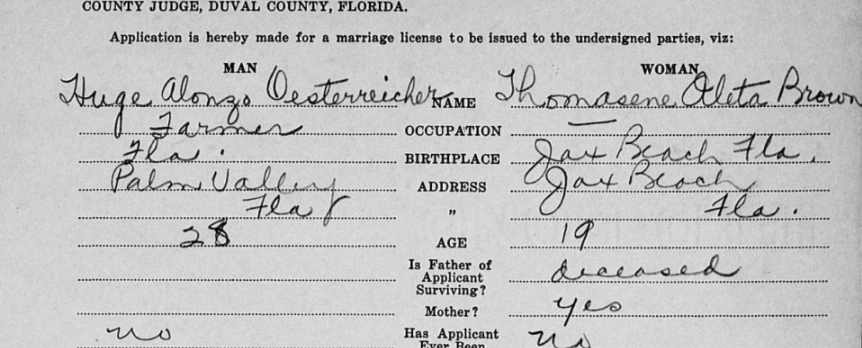
In time, everything east of the San Pablo River from the St. Johns County line and north to the Neptune Beach city limits would be Jacksonville Beach because of annexations and real estate development. The characteristics would change. The percentages of African Americans and children would decline. The percentages of white, other races or combination of races, and people over 65 would increase as the following table derived from Census Viewer for Jacksonville attests.
|
||||||||||||||||||||||||||||||||||||||||||||||||||||||||||||||||||||||||||||||||||||||||||||||||||||||||||||||||||||||||||||||||||||||||||||||||||||||||||
There are those who say that things were better a century ago, that life was simpler, easier, and more straight forward. They are wrong. Life was a struggle.
1 For my purposes, I define these as Mayport, Atlantic Beach, Neptune Beach, and Jacksonville Beach in Duval County and Ponte Vedra Beach and Palm Valley in St. Johns County as "the beaches." Confusion may arise because Duval County-Jacksonville uses a federal system that means that Atlantic, Neptune, and Jacksonville Beaches as separate cities while also being part of the City of Jacksonville. See the bibliography for my historical writings concerning this area.
2 See Donald J. Mabry, I've Been Working on the Railroad. HTA Press, 2012 (http://www.historicaltextarchive.com/books.php?action=nextpre&bid=74) for the best account of the railroads to the beach.
3 It is possible that a private home dates from 1910 or before.
4 The Ocean Beach Reporter celebrated the founding of the town in its April 26, 1957 special edition. It incorrectly asserted that the northern boundary of the town was 12th Avenue North but Wakulla Avenue was three blocks further north and that the western boundary was the "canal" or Pablo Creek/San Pablo River to the west. The western boundary was 10th street. Florida, Acts and Resolutions Adopted by the Legislature of Florida, Tallahassee, 1907.
5 Frederick T. Davis, History of Jacksonville, Florida and Vicinity, 1513 to 1924. Jacksonville, 1925. 233.
6 Twentieth-first century street names have been added in parentheses. In 1937, the east-west streets north of Putnam and south of Duval were numbered. Leon Avenue became Dickerson Avenue and then 1st Avenue North; Shockley Avenue became 1st Avenue South.
7 Gathering biographical information was laborious and required searching many places with few results. Census records, both Florida and the U. S. census, were very helpful. Jacksonville city directories, genealogical sites and scattered other sources provided data but not as much as I would have liked. The bibliography lists sources.
8 Delaware State Reporter (August 20 1858).
9 William Knauer and his wife Pearl D. Boreen, born in Tupelo, Mississippi in 1872, produced a son William Jerome Knauer, Sr. ( born May 12, 1896 in Jacksonville, Florida)who became a medical doctor. He lived in Jacksonville Beach for a time and died August 20, 1989 in Jacksonville. Ottilie's brother Max Christian Knauer, born in Gotha in 1875, married a Czech woman, and sired Helen Louise Knauer in 1902. She married Walter Dare Dickinson, Sr. Their children are Maxwell Knauer Dickinson, Walter Dare Dickinson, Jr., Franklin Frazier Dickinson, and Carol "Petra" Down Dickinson. The Dickinsons have been a very prominent Beaches family.
10 United States. Dept. of the Interior, Official register of the United States: containing a list of officers and employees in the civil, military, and naval service on the First of July, 1981, Volume 2. (Washington, GPO, 1892), p. 502.
11 United States Congressional Serial Set. Washington: U. S. Government Printing Office, 1895), p.75
12 "My agent, Mr. H. M. Shockley, rented it to Sergeant Reed for Lieutenant Tillibury, of the Second New Jersey United States Volunteers, for an office. The United States forces consisting of regiment, while camped at Pablo Beach in the month of September 1898, "Elihu Root, Elihu Root Collection of United States Documents: Ser: A-F. (Washington, GPO, 1895-1908) Pp. 64-70.
13 Florida. Office of Secretary of State, Report of the Secretary of State of the State of Florida, Tallahassee, 1909, p. 425.
14 "Perkins v. O'Donald et al." The Southern Reporter, Vol. 82 (1920), p. 403. Mary E. Perkins owned Perkins Hotel and Perkins Bathhouse.
15 Harry Gardner Cutler, History of Florida: Past and Present, Historical and Biographical, Volume 2 (NY: Lewis Publishing Company, 1923). p. 91 asserts that the state legislature gave summer residents to vote in elections.
16 The name is also spelled Griner when it has been Anglicized, which my ancestors did.
17 The brochure is in the archives of the Beaches Museum and History Park in Jacksonville Beach, Florida.
18 My sources sometimes spelled the surname Gonzalez; in Spanish, the two spellings sound the same.
19 Ed Gerkin (36),an actor, was born in North Carolina as were his parents. He was married to Lula, 28, a Georgia native for 6 years. They had a son, Ed Jr. who was 3 and born in Georgia so Gerkin was a relative newcomer. One wonders how he found work as an actor in such a small place. Maybe that is why he ran for public office.
20 The official date of the 1910 U.S. Census was April 15, 1910.
22 Jack Pate, "Cora Crane", Tidings From the First Coast Beaches, published by the Beaches Area Historical Society.
A work such as this relies upon others. Family Search and Google Books are two superlative Web sites. The City of Jacksonville Public Library Special Collections is a gold mine not only for it online collection of city directories and old postcards but also for the help its staff gives. Thanks Adam Barmer. Robert Dorough, who lived next door to Mrs. Shockley and was friends with her was a special help.Various people helped me decipher the handwriting on census forms--Paula Mabry, Hasan B. Paksoy, Jeff Howell, and Mark Phillip Simmons. Simmons was a whiz in how fast he could do it and generous with his time as he found additional information. I am beholden to him for the 1910 photographs. The Beaches Museum and History Park in Jacksonville Beach, Florida is indispensable for anyone trying to discover the past of the beaches and write history. I am thankful that Taryrn Rodríguez-Boette is the archivist. The bibliography does not show all the sources I consulted during my many months of research.
All errors are mine.
"Anything on Wheels Eligible," The Motor Way, Volume 14 (1906), pp. 18.
archives.com
Burmeister Caren, "When hogs had to be banned from town," Shorelines, Florida Times-Union (May 26, 2007).
Burr, Carleton, The Jacksonville Beach Story. Self-published. Jacksonville Beach?, 1965.
Census Viewer. : http://censusviewer.com/city/FL/Jacksonville%20Beach
Cutler, Harry Gardner, History of Florida: Past and Present, Historical and Biographical, Volume 2 (NY: Lewis Publishing Company, 1923).
Davis, Frederick T. History of Jacksonville, Florida and Vicinity, 1513 to 1924. Jacksonville, 1925.
Delaware State Reporter (August 20 1858).
Electrical Engineering, Volume 46 (Southern Electrician Publishing Company, 1914), pp. 436.
Florida, Acts and Resolutions Adopted by the Legislature of Florida, Tallahassee, 1907.
Florida, General Acts and Resolutions Adopted by the Legislature of Florida. Chapter 6382 (No. 263) . Tallahassee, W. & C. Julian Bartlett, 1911, Pp. 709-710.
Florida, Marriages, 1837-1974. Available on FamilySearch (familysearch.org )
Florida. Office of Secretary of State, Report of the Secretary of State of the State of Florida, Tallahassee, 1909.
"Good Ol' School Days at the Beach," The Beaches Magazine (Fall, 2008).
Henry, Harley, "A Brief History of St. Paul's
by-the-Sea," St. Paul's by-the-Sea web site, www.spbts.net/our-history.php, on
March 23, 2012.
Henry, Harley, Unpublished manuscript, "A Chronology of St. Paul's by the Sea Episcopal Church, Jacksonville Beach, Florida. Revised May, 2007.
Herringshaw's National Library of Biography. Chicago, American Publisher's Association, 1909.
Industrial Refrigeration, Volume 31 August, 1906, page 72 .
"Jacksonville Beach Looks Back on 50 Years of History," Ocean Beach Reporter, Friday, April 26, 1957.
Jacksonville City Directories. Found online in the Florida Collection, City of Jacksonville Public Library at http://jpl.coj.net/coll/florida/cdindex.html.
Mabry, Donald J., " WWI Veterans: Jacksonville Beaches & Mayport," HTA Press, 2007, Revised 2008.
Mabry, Donald J., "A Man and Three Hotels," HTA Press, March, 2006.
Mabry, Donald J., "Baseball on the Beach: Sea Birds, 1952-54," HTA Press, 2008.
Mabry, Donald J., "Beach Builder: B. B. McCormick," HTA Press, March 2012.
Mabry, Donald J., "Carnival on the Boardwalk," HTA Press, 2009.
Mabry, Donald J., "Florida's Napoleon," HTA Press, 2008.
Mabry, Donald J., "Harcourt Bull's Atlantic Beach, Florida," HTA Press, February, 2007.
Mabry, Donald J. I've Been Working on the Railroad. HTA Press, 2012
Mabry, Donald J., "Mighty Mayport Florida Beats Jacksonville," HTA Press, 2009.
Mabry, Donald J., "Neptune Beach, Florida Before 1931, " HTA Press, October, 2006.
Mabry, Donald J., "Uncovering African American Micro History" HTA Press, 2010.
Mabry, Donald J., "Yankee Engineer in Florida" HTA Press, 2010.
Mabry, Donald J., "Yankee Engineer in Florida: Frederick William Bruce," The Southern Genealogist's Exchange Quarterly, Vol. 53, No. 221, March 2012.
Mabry, Donald J., "What A Man! John G. Christopher", Historical Text Archive, tinyurl.com/bvgnjhp.
Mabry, Donald J., World's Finest Beach. HTA Press, 2006.
Mabry, Donald J., World's Finest Beach: A Brief History of the Jacksonville Beaches. Charleston: The History Press, 2010.
Makers of America: An Historical and Biographical Work by an Able Corps of Writers By Florida historical society.. A. B. Caldwell, Jacksonville, FL, 1909.
Manufacturers' Record, Volume 81, Issues 14-26, page 109.
Municipal Journal & Public Works, Volume 31, 1911, 127
Ocean Beach Reporter (April 26, 1957) special edition.
Pablo Beach Improvement Company, Inc. Brochure, 1913.
Pablo City Election Passed Off Quietly," Florida Times-Union, July 13, 1910.
Pate, Jack, "Cora Crane", Tidings From the First Coast Beaches, published by the Beaches Area Historical Society.
"Perkins v. O'Donald et al." The Southern Reporter, Vol. 82 (1920), p. 403.
Ray, Glenn B. http://boards.ancestrylibrary.com/surnames.rauch/6.12.24.53/mb.ashx
Rerick, Rowland H., Memoirs of Florida, Vol. 1 . Edited by Francis P. Fleming. Atlanta: Southern Historical Association, 1902.
Root, Elihu, Elihu Root Collection of United States Documents: Ser: A-F. (Washington, GPO, 1895-1908).
Scull, Eleanor, "Ruby Beach," American Life Histories: Manuscripts from the Federal Writers' Project, 1936-1940, America Memory, Library of Congress. Jacksonville. Florida.
The Leucocyte, 18:1 (October 15, 1910).
Transactions of the Florida Medical Association. 1905.
United States Census, 1850-1940, Available on FamilySearch (familysearch.org)
United States Congressional Serial Set. Washington: U. S. Government Printing Office, 1895), p.75
United States. Department of the Interior, Official register of the United States: containing a list of officers and employees in the civil, military, and naval service on the First of July, 1891, Volume 2. (Washington, GPO, 1892).
06062013